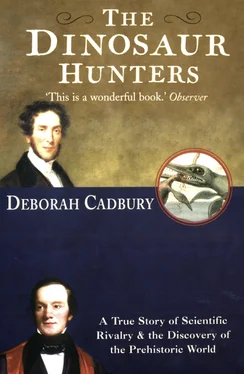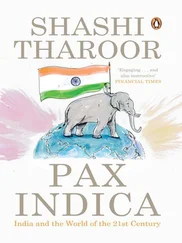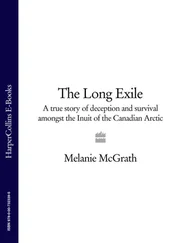In France, Lamarck had difficulty even in obtaining publishers for his ideas. Cuvier was so antagonistic to this ‘evolutionary’ thinking, it is thought that he advised the Emperor Napoleon not to accept a copy of Lamarck’s Philosophie Zoologique. It was a well-orchestrated public humiliation. In his lectures, Cuvier scoffed at the notion that organs could be formed by frequent use. He challenged Lamarck’s view that the entire animal kingdom was united in one genealogical tree. Cuvier believed that the differences between, for example, a humble mollusc and a complex vertebrate were so great that they could not possibly have arisen from a continuous chain.
Cuvier had developed a different theory to account for extinction, called the ‘Doctrine of Catastrophes’, according to which violent ‘revolutions’ had wiped away former worlds, destroying ancient forms of life. These ideas stemmed from a study he had undertaken with another colleague at the Muséum National d’Histoire Naturelle, the Professor of Mineralogy Alexandre Brongniart. Together they made a special study of the conditions under which fossils had become entombed in the Tertiary rocks of the Paris basin. For four years, almost every week, they took the carriage into the countryside around the River Seine.
Above the chalk of the Secondary strata they identified several major Tertiary formations. Each layer of rock had its own characteristic fossils, some containing marine invertebrates, others only freshwater creatures. These alternating layers of marine and freshwater formations led the two scientists to conclude that there had been repeated incursions of sea. Because there were ‘abrupt junctions’ between the marine and freshwater formations, they reasoned, the ocean had invaded suddenly, submerging the land for prolonged periods and destroying living species.
The ancient globe, Cuvier reasoned in his Essay on the Theory of the Earth, was punctuated by a series of ‘revolutions that were so stupendous that … the thread of Nature’s operations was broken by them and her progress altered’. He envisaged that prior to the creation of Man there were several different periods in the earth’s history, shown by the many different layers of rock in the earth’s crust that were filled with fossils. Each period ended in a dramatic geological ‘catastrophe’ in which species became extinct. ‘Life has often been disturbed on this earth by terrible events,’ wrote Cuvier. ‘Numberless living beings have been the victims of these catastrophes; their races have even become extinct.’
When Cuvier’s Essay was translated into English, the editor, Professor Robert Jameson of Edinburgh University, presented Cuvier’s theory as though the most recent ‘catastrophe’ was the biblical Flood. This was an obvious mistranslation of the Frenchman’s original ideas, which were based upon research within the Paris basin. Nevertheless, in England this was embraced as authoritative scientific backing for the Bible. William Buckland praised Cuvier’s ‘inestimable Essay’, and was eager to extend his notion of incursions of sea to ‘a recent Deluge acting universally over the surface of the whole globe’. He also hoped to show how this might correspond with the layers of rock that formed the earth’s crust.
By 1821, Buckland and his friends at the Geological Society had made considerable progress mapping the succession of strata in England. Following William Smith’s earlier studies, they identified several major formations in the Secondary series, complementing Cuvier’s studies of the Tertiary rock above. There was still little known about the oldest Primary and Transition layers. Nonetheless, Buckland and his colleagues had glimpsed as far back in time as the period now known as ‘Devonian’, the lowermost Secondary rocks. They called these ancient rocks the ‘Old Red Sandstone’. Above this, Buckland identified later rock formations: ‘Carboniferous Limestone’, succeeded by the ‘Coal Measures’, ‘New Red Sandstone’ (Triassic), ‘Jura limestone’ (Jurassic), and finally the most recent chalk and greensand (Cretaceous). These formations together made up the major periods of the Secondary series. Sadly for William Smith, when the gentlemen geologists of the Geological Society of London published their map, sales of his own map were cut to nothing. Smith became so poor that at one stage he was even reduced to spending time in a debtors’ prison.
Although little was known about the fossils in the different layers, this classification of the Secondary rocks proved to be remarkably accurate and still stands up to scrutiny today. Since, as James Hutton had argued, each layer of rock was formed imperceptibly, the result of gradual erosion and deposition over countless years, this classification lent powerful support to the idea of vast geological epochs before the creation of Man. Buckland was beginning to glimpse distinct periods in which centuries of prehistory buried in the earth’s crust could be defined.
Buckland was keen to integrate all these threads of evidence: the succession of strata, Cuvier’s ‘catastrophes’ and biblical records of a Flood. His opportunity came later in 1821, when quarrymen stumbled upon a cave at Kirkdale in Yorkshire containing ancient fossil bones. He hurried to the site, suspecting this would provide further insights. Surely the animals in the cave had been swept in by the terrifying, swirling Flood waters? What he found was stranger than anything he could have imagined.
Deep into the cave he went, on his hands and knees, the circle of light from a candle allowing him brief glimpses of what lay ahead, the voices of his companions echoing in the ancient silence. Undisturbed for centuries, the cave divided into passages that stretched back two hundred feet into the hillside. At first, all he could see was mud and silt. Gradually, it became clear that the scene was much more gruesome. Partially obscured by stalagmites and stalactites, ‘the bottom of the cave was strewed all over, from one end to the other, with hundreds of teeth and bones’. ‘Scarcely a single bone has escaped fracture,’ he said.
Drawings of the fossils were sent to Georges Cuvier, who confirmed Buckland’s suspicions that the bones were from many different animals jumbled together in disarray. These were creatures that never live together: tigers and deer, bears and horses, in addition to extinct species of elephant, rhinoceros, hippopotamus and hyenas. Furthermore, it was hard to envisage how large animals such as elephants could have passed through the two-foot entrance to the cave. Even more puzzling, Buckland observed from the splintered fragments and gnaw marks, all the bones appeared to have been half-eaten.
Buckland began to suspect that this was an ancient hyena den; the larger animals had been dragged into the cavern, a portion of the carcass at a time. He imported a hyena from the Cape and compared the gnaw marks on bones eaten by it with those from the caves. He soon wrote jubilantly to a friend, the Reverend Vernon Harcourt: ‘Billy [the hyena] has performed admirably on shins of beef, leaving precisely those parts which are left at Kirkdale and devouring what are there wanting … So wonderfully alike were these bones in their fracture … that it is impossible to say which bone had been cracked by Billy and which by the hyenas of Kirkdale!’
Buckland gathered more than three hundred hyena canine teeth from the cavern, and the bones of over seventy-five hyenas. Comparing these to skeletons of living species, Cuvier showed ‘that the fossil hyena was nearly one third larger than the largest of modern species. Its muzzle was shorter and stronger … and its bite more powerful.’ Since it was a species of hyena from genera that now only inhabit the tropics, Buckland reasoned that there had once been a tropical climate in Northern Europe. His interpretation of the cave as an ancient hyena den has proved correct, and when he presented his ideas to the Royal Society they were so well received that he was honoured with the Society’s prestigious Copley medal, never before given to a geologist.
Читать дальше












